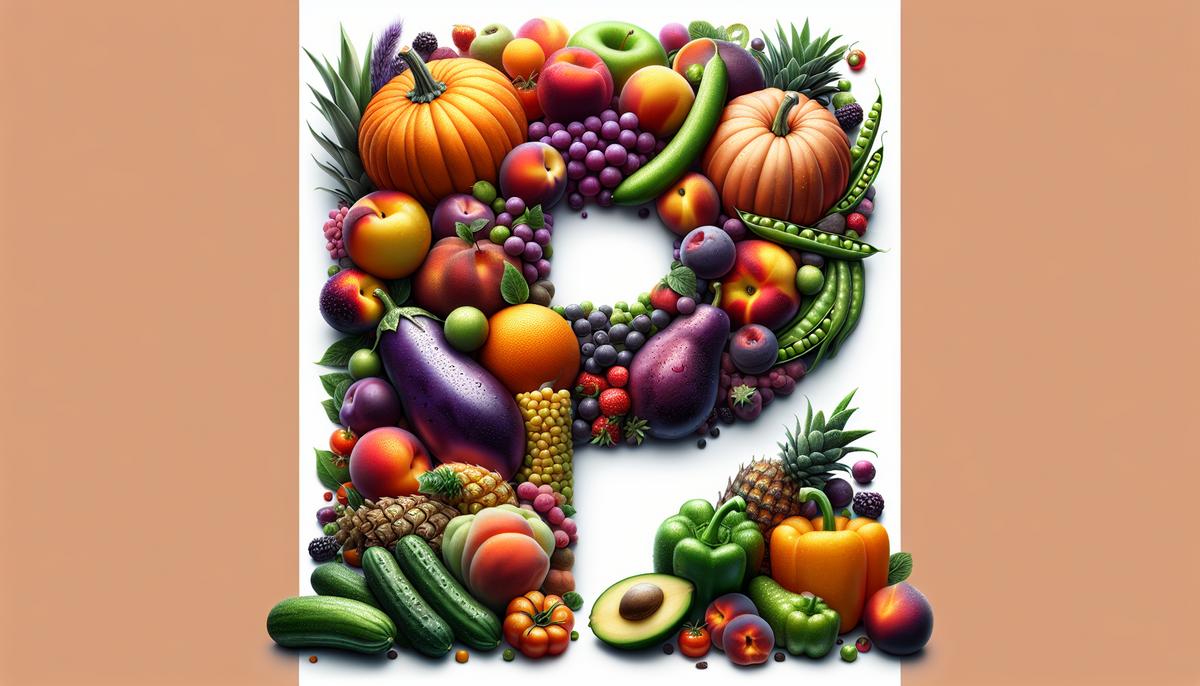Eating a diet rich in fruits and vegetables is one of the best ways to maintain a healthy lifestyle. With a variety of textures, flavors, and colors, fruits and vegetables offer an enjoyable way to get the nutrients your body needs. Today, we’re focusing on some fantastic options that all share the same initial—R. These fruits and vegetables are not only delicious but also packed with essential vitamins and minerals. From vibrant Rainier cherries to the versatile rutabaga, this guide will introduce you to a selection of “R” fruits and vegetables that can enhance your meals and boost your health.
Fruits that start with R
Rainier Cherries
Rainier cherries are a delightful summer fruit known for their striking color and sweet taste. These cherries are easily recognizable by their yellowish-red hue and are often larger than other cherry varieties. Named after Mount Rainier in Washington, they are highly prized for their unique flavor and juicy texture, making them a favorite among cherry lovers.
Nutritionally, Rainier cherries are a powerhouse of antioxidants, including vitamin C and beta-carotene. They are also a good source of potassium, which is essential for heart health and muscle function. Additionally, the anthocyanins found in cherries have anti-inflammatory properties that can help reduce the risk of chronic diseases.
In the kitchen, Rainier cherries are incredibly versatile. Enjoy them fresh as a snack or add them to salads for a pop of color and sweetness. They can also be used in desserts like cherry pie or clafoutis, and they pair wonderfully with savory dishes, such as grilled meats or cheese platters.
Raisins
Raisins are dried grapes that have been enjoyed for their natural sweetness and convenience for thousands of years. They come in various colors, including golden, brown, and black, depending on the type of grape used. Raisins are a staple in many cultures and are used in both sweet and savory dishes.
From a nutritional standpoint, raisins are rich in iron, which is crucial for the production of red blood cells. They also provide a good amount of dietary fiber, aiding in digestion and helping to maintain healthy blood sugar levels. Furthermore, raisins contain antioxidants like resveratrol, which has been linked to heart health.
Culinarily, raisins can be used in a multitude of ways. They make an excellent addition to breakfast cereals and oatmeal or can be mixed into yogurt. In baking, they add natural sweetness to cookies, breads, and cakes. Raisins are also a key ingredient in many savory dishes, such as couscous, pilafs, and salads, adding a burst of flavor and texture.
Raspberries
Raspberries are small, delicate fruits known for their vibrant red color and tart-sweet flavor. These berries are composed of numerous drupelets, each containing a seed, which gives them their unique texture. Available in red, black, purple, and even golden varieties, raspberries are a favorite in both fresh and frozen forms.
Raspberries are incredibly nutritious, offering a high amount of dietary fiber, which is beneficial for digestive health. They are also rich in vitamin C, essential for immune function, and contain manganese, which plays a role in bone health. Additionally, raspberries are packed with antioxidants, such as quercetin and ellagic acid, which may help reduce inflammation and protect against certain diseases.
In terms of culinary uses, raspberries are extremely versatile. They can be enjoyed fresh on their own or added to a variety of dishes. Use them to top cereals, yogurt, and salads, or blend them into smoothies. Raspberries are also fantastic in baked goods like muffins, tarts, and pies, and they make a delicious addition to sauces and dressings.
Red Banana
Red bananas are a unique variety of banana with a reddish-purple skin and a sweet, creamy flesh. Smaller and plumper than the more common yellow bananas, red bananas are often described as having a slightly berry-like flavor in addition to their banana taste. They are popular in many tropical regions and are becoming more widely available in other parts of the world.
Nutritionally, red bananas offer several benefits. They are rich in vitamin C, which supports immune health, and vitamin B6, which is important for brain function and metabolism. Red bananas also contain a good amount of dietary fiber, which aids in digestion, and they are a source of potassium, which helps regulate blood pressure.
In the kitchen, red bananas can be used much like their yellow counterparts. Enjoy them fresh as a snack or add them to fruit salads and smoothies. They can also be used in baking, such as in banana bread or muffins. Red bananas are delicious when cooked; try them grilled, fried, or sautéed for a tasty dessert or side dish.
Red Currants
Red currants are small, glossy berries that grow in clusters on shrubs. They have a tart flavor and are commonly used in European cuisines. Their bright red color and juicy texture make them a visually appealing and tasty addition to various dishes.
These berries are nutritionally impressive, providing a significant amount of vitamin C, which is crucial for immune health and skin vitality. Red currants are also rich in antioxidants, including flavonoids, which help combat oxidative stress. Additionally, they contain dietary fiber, which promotes healthy digestion.
Culinary uses for red currants are diverse. They can be eaten fresh, though their tartness might be intense for some. Red currants are often used in jams, jellies, and sauces, providing a balance of sweetness and acidity. They also make an excellent garnish for desserts and can be incorporated into baked goods like tarts and cakes.
Rose Apple
Rose apples, also known as wax apples or water apples, are tropical fruits that belong to the myrtle family. They are bell-shaped with a crisp texture and a flavor that resembles a blend of apple and rosewater. The fruit is usually light pink or red and is prized for its refreshing taste.
Rose apples are a good source of vitamins A and C, both of which are essential for maintaining healthy skin and immune function. They also contain dietary fiber, which aids in digestion, and small amounts of calcium and iron, contributing to bone health and blood production.
In the culinary world, rose apples can be enjoyed fresh or used in various dishes. They are often eaten raw as a hydrating snack or added to fruit salads. Rose apples can also be used in making juices, jams, and jellies. In some cultures, they are cooked into savory dishes, providing a unique flavor that complements meats and seafood.
Vegetables that start with R
Radicchio
Radicchio is a type of chicory with distinctive red leaves and white veins. It has a slightly bitter taste, which mellows when cooked. Often mistaken for red cabbage, radicchio is a staple in Italian cuisine and adds a vibrant color and unique flavor to dishes.
Nutritionally, radicchio is low in calories but high in vitamins K and C. Vitamin K is essential for blood clotting and bone health, while vitamin C is important for immune function. Radicchio also provides a good amount of antioxidants, which help protect the body from oxidative stress and inflammation.
Culinary uses for radicchio are varied. It can be eaten raw in salads, where its bitterness can be balanced with sweet or tangy dressings. Radicchio is also delicious when grilled or roasted, which enhances its natural sweetness. It can be added to pasta dishes, risottos, and even used as a pizza topping.
Radish
Radishes are root vegetables known for their peppery flavor and crunchy texture. They come in various colors, including red, white, pink, and purple, and can be round or elongated. Radishes are a common ingredient in salads and are enjoyed worldwide.
From a nutritional perspective, radishes are low in calories but rich in vitamin C and potassium. Vitamin C supports the immune system and skin health, while potassium helps regulate blood pressure. Radishes also contain antioxidants like catechins, which have anti-inflammatory properties.
In the kitchen, radishes are incredibly versatile. They can be eaten raw, adding a spicy crunch to salads and sandwiches. Radishes can also be pickled, which mellows their heat and adds a tangy flavor. Cooking radishes, whether roasting or sautéing, softens their texture and brings out a subtle sweetness.
Red Kidney Beans
Red kidney beans are a popular legume known for their kidney-like shape and deep red color. They are a staple in many cuisines, including Mexican, Indian, and Creole. Kidney beans have a mild, creamy texture that makes them a versatile ingredient in a variety of dishes.
Nutritionally, red kidney beans are an excellent source of plant-based protein and dietary fiber, making them a great option for vegetarians and vegans. They also provide essential nutrients like iron, folate, and magnesium. Additionally, kidney beans contain antioxidants that can help reduce the risk of chronic diseases.
In culinary applications, red kidney beans shine in dishes like chili, soups, and stews. They can be added to salads for extra protein and fiber or used in making bean burgers. Kidney beans are also a key ingredient in traditional dishes like red beans and rice, showcasing their versatility and ability to absorb flavors.
Red Leaf Lettuce
Red leaf lettuce is a type of loose-leaf lettuce with vibrant red-tinted leaves. It has a mild, slightly sweet flavor and a tender texture, making it a popular choice for salads and garnishes. The colorful leaves add visual appeal to dishes and provide a nutritional boost.
This leafy green is rich in vitamins A and K, both of which are important for eye health and bone strength. Red leaf lettuce also contains folate, which is essential for DNA synthesis and cell division. Additionally, it provides a good amount of antioxidants, which help protect the body from free radical damage.
In the kitchen, red leaf lettuce is often used in salads, where its delicate flavor pairs well with a variety of dressings and toppings. It can also be used as a garnish for sandwiches and burgers or as a bed for grilled meats and vegetables. Red leaf lettuce is a versatile ingredient that adds color and nutrition to any meal.
Red Potatoes
Red potatoes are small to medium-sized potatoes with a smooth, red skin and white flesh. They have a slightly waxy texture and a mild, earthy flavor. Red potatoes hold their shape well during cooking, making them ideal for a variety of dishes.
Nutritionally, red potatoes are a good source of vitamin C, potassium, and dietary fiber. Vitamin C is important for immune function and skin health, while potassium helps regulate blood pressure. The fiber content in red potatoes aids in digestion and promotes a feeling of fullness.
Red potatoes are incredibly versatile in the kitchen. They can be boiled, roasted, or mashed and used in soups, stews, and salads. Their firm texture makes them perfect for potato salads, and they are also delicious when roasted with herbs and spices. Red potatoes can be used in any recipe that calls for potatoes, adding a unique flavor and texture.
Rhubarb
Rhubarb is a perennial vegetable known for its tart, tangy flavor and bright red stalks. Often mistaken for a fruit, rhubarb is commonly used in sweet dishes due to its sour taste. The leaves of the rhubarb plant are toxic and should not be consumed, but the stalks are edible and highly prized.
Rhubarb is low in calories and high in dietary fiber, which aids in digestion. It is also a good source of vitamins K and C, both of which are important for bone health and immune function. Rhubarb contains antioxidants like anthocyanins, which give the stalks their red color and have anti-inflammatory properties.
In the culinary world, rhubarb is most commonly used in desserts. It is often paired with strawberries in pies, crisps, and jams to balance its tartness. Rhubarb can also be used to make sauces, chutneys, and even beverages like rhubarb lemonade. When cooking with rhubarb, it’s important to add sweeteners to counteract its natural sourness.
Romaine Lettuce
Romaine lettuce is a popular leafy green known for its long, sturdy leaves and crisp texture. It has a mild flavor and is commonly used in salads, especially Caesar salad. Romaine lettuce is a staple in many households and is valued for its versatility and nutritional benefits.
This lettuce variety is rich in vitamins A and K, both of which are essential for eye health and bone strength. Romaine lettuce also provides folate, which is important for DNA synthesis and cell division. Additionally, it contains a good amount of antioxidants, which help protect the body from free radical damage.
Culinary uses for romaine lettuce are extensive. It can be used in salads, providing a crisp texture and a refreshing taste. Romaine lettuce is also excellent in sandwiches and wraps, adding a crunchy element. It can even be grilled or roasted for a unique twist, enhancing its natural sweetness and flavor.
Rutabaga
Rutabaga, also known as swede, is a root vegetable that is a cross between cabbage and turnip. It has a round shape with yellowish flesh and a slightly sweet, earthy flavor. Rutabagas are often used in hearty dishes and are popular in many European cuisines.
Nutritionally, rutabagas are a great source of vitamin C, which supports the immune system and skin health. They also provide a good amount of dietary fiber, aiding in digestion and promoting a feeling of fullness. Rutabagas contain potassium, which helps regulate blood pressure, and antioxidants that can help reduce inflammation.
In the kitchen, rutabagas can be used in a variety of ways. They can be roasted, mashed, or added to soups and stews for a hearty flavor. Rutabagas are also delicious when pureed and used as a side dish, similar to mashed potatoes. Their slightly sweet taste makes them a versatile ingredient in both savory and sweet dishes.




